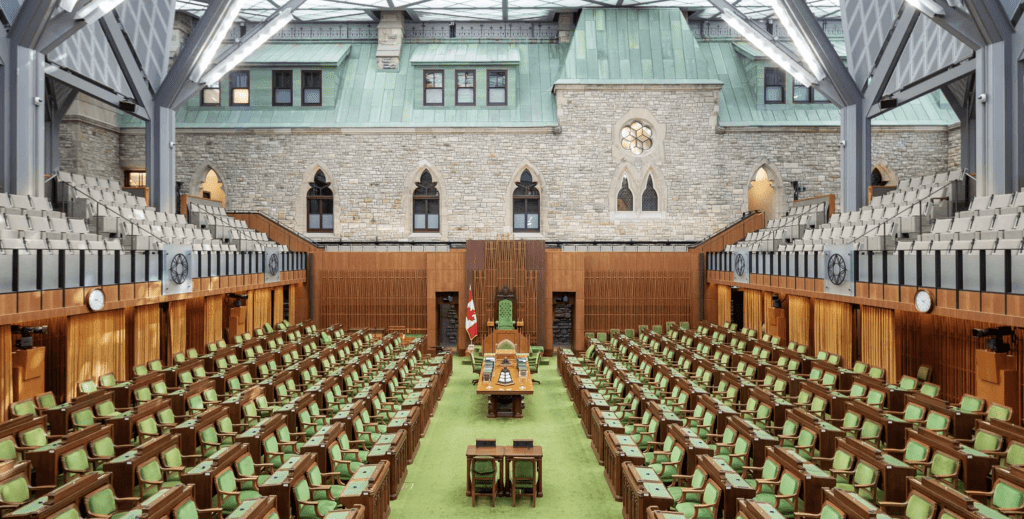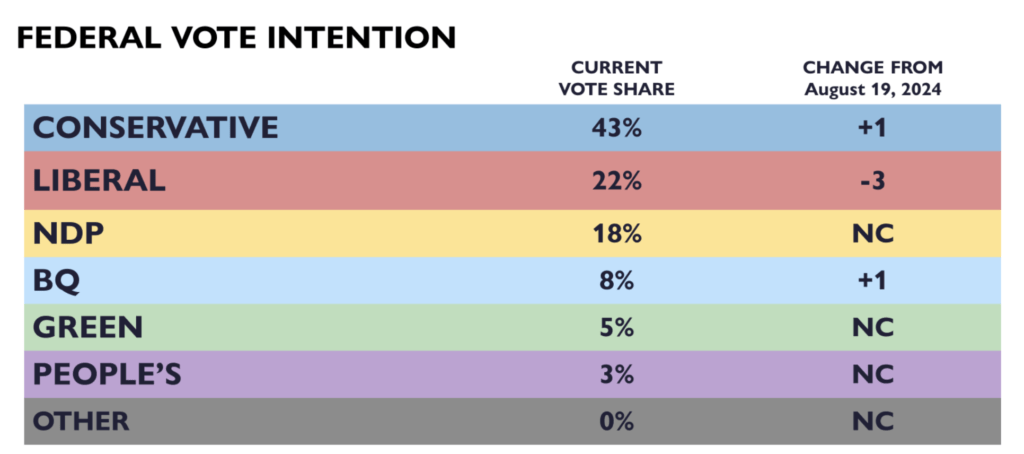Welcome Back, to a Fractious, Survivalist, Precarious Parliament
With the supply and confidence deal between the NDP and minority Liberal government mothballed and all parties facing the pressure of political volatility and “promiscuous” voters, it will be an interesting fall.
 parl.ca
parl.ca
By Lori Turnbull
September 15, 2024
For months, Canadian public opinion polls have shown such a daunting lead for the Conservatives that a majority government for Pierre Poilievre looks increasingly like a foregone conclusion. As Parliament returns for the fall sitting, Abacus Data‘s September 15th polling (conducted from September 5 to 12) puts the Conservatives a solid 21 points ahead of the Liberal Party with 43% of the popular vote. Twenty-two percent of respondents would vote Liberal if the election were held today, compared with 18% for the New Democrats and five percent for the Greens.
 Abacus Data
Abacus Data
Though this is obviously encouraging news for the Conservatives, and potentially devastating for the Liberals, these national numbers don’t tell the whole story. The Liberals and the NDP are battling one another as well as the Bloc Quebecois for a second-place finish. The effects of vote-splitting in key ridings combined with the lack of popularity of the three major party leaders make it difficult to predict how the next Parliament will be composed.
This fall is shaping up to be a season of even greater political uncertainty in Canada than was foreseeable even a month ago. Now that the supply and confidence agreement between the Liberals and the NDP has ended, it is not clear how long the government will last. The Conservatives have promised to bring a motion of non-confidence in the Trudeau government as soon as possible and are daring (read: bullying) the NDP to put their money where their mouth is and vote with them to compel an election.
This would help the Conservatives to cash in on their lead in the polls but would jeopardize the pharmacare deal that is currently on the legislative docket in the Senate. Do Conservatives — and the NDP, whose partnership with the Liberals was rationalized by pharmacare — want to risk a potential voter backlash in that event? Or, do voters care enough about pharmacare to punish the Conservatives and the NDP if it doesn’t come through?
The Conservative lead is significant but, due to Pierre Poilievre’s polarizing persona, there is reason to think that some voters who are currently leaning his way might be persuaded to vote for someone else if a viable option presented itself. Abacus also found that, that while positive impressions of Poilievre are at 39%, negative impressions are close behind at 35%. This is not exactly Poilievre-mania.
That’s a big part of why Jagmeet Singh and the NDP need to differentiate themselves from the Liberals now, before it’s too late. Their decision to break ranks with the Liberals in advance of Parliament’s return is less about concern with the latter’s greed, weakness, and corporate ties (however useful this narrative could be at election time), than it is a strategic move to show up differently in ridings where the NDP stands a chance of winning due to collapsing support for the Liberals and hesitancy around Poilievre and the Conservatives.
Ironically, by ditching the supply and confidence deal and making this Parliament more precarious, Singh may have saved not just Trudeau’s leadership from a putsch, but his own.
Justin Trudeau continues to cling to the Liberal leadership despite loud and persistent calls, both inside and outside the Liberal “house”, for him to do otherwise. He insists he’s not going anywhere even though his negative impressions are worse than Poilievre’s, at 61% compared to 22% of respondents reporting having positive impressions of him. Who knows how things could have been different had Trudeau stepped aside to let someone take over; it is too late now.
Trudeau is banking on his hunch that people’s dislike of Poilievre and distrust of his intentions will overcome voter fatigue with the Liberals and lure voters back to them once the election campaign is underway in earnest. However, given the fact that more voters dislike Trudeau than Poilievre, Liberal efforts to undermine the Conservatives could end up driving voters to the NDP.
It’s up to to the NDP to be that viable alternative but Singh’s impressions are at 33% positive and 35% negative. In other words, voters don’t like him either, and after two federal elections as NDP leader, he can’t really argue they don’t know him. Ironically, by ditching the supply and confidence deal and making this Parliament more precarious, Singh may have saved not just Trudeau’s leadership from a putsch, but his own.
The Bloc Quebecois are the eternal wild card in Canadian politics, particularly now that the NDP have pulled their blanket support for the Liberals. There is now a window for the Bloc to support Liberal legislation and keep the government alive in exchange for measures favourable to Quebec. But given the Liberals’ dependence on Quebec to keep them alive, there is high risk in making the Bloc look effective.
Adding to the uncertainty are the shifting tectonic plates underpinning Canada’s political party system. It’s not 1985 anymore, or even 2004 for that matter. The Liberals are farther to the left than ever. Many working-class voters are leaving the NDP in favour of the Conservatives and feel that, like him or not, Poilievre is best able to manage the affordability crisis. The Conservatives seem to be appealing more broadly than they normally do, but whether this support is committed or fragile is unclear.
The parties are less able to count on their traditional bases, are more vulnerable to voter “promiscuity,” and are all fighting in all directions for every vote they can get. The political centre seems to lack a voice altogether, despite large numbers of Canadians identifying as such. That’s perhaps the most paradoxical thing of all: the failure of parties to meet Canadians where they are, even if only for their own gain. No wonder voter apathy is a problem.
This week’s byelections will set the stage for what is likely to be a fractious, survivalist Parliament. The general election is almost guaranteed to be earlier than the scheduled date of October 20, 2025, so the parties have a limited time to make their respective cases to the voters. The polls keep telling us that the Conservatives will win by a landslide, but the overall election result is far from certain. This fight is not over.
Lori Turnbull is a Policy contributing writer and professor in the Faculty of Management at Dalhousie University.
